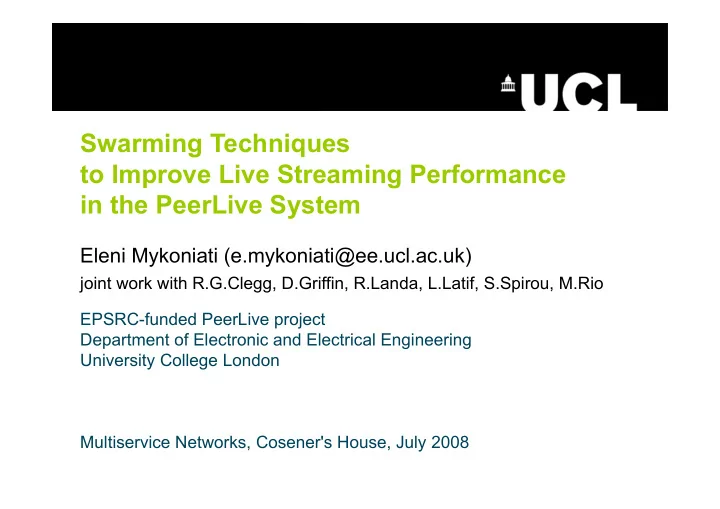

Swarming Techniques to Improve Live Streaming Performance in the PeerLive System Eleni Mykoniati (e.mykoniati@ee.ucl.ac.uk) joint work with R.G.Clegg, D.Griffin, R.Landa, L.Latif, S.Spirou, M.Rio EPSRC-funded PeerLive project Department of Electronic and Electrical Engineering University College London Multiservice Networks, Cosener's House, July 2008
live streaming & related performance aspects peercaster 1 2 3 4 5 6 7 8 6 chunk production time 3 7 3 4 5 7 5 6 1 8 2 consumer 7 4 1 3 4 playout point 1 2 3 4 5 6 chunk playing time • playout lag = how far is the playout point from the livest chunk at the peercaster • playout continuity = the percentage of chunks not received in time for the playout • startup delay = time elapsed until the playout starts
improving playout lag – locality and clusters stream-2 clusters stream-1 clusters delay space geographical space
improving startup delay – fast peer discovery • discover the nearest local tracker for a particular stream • Distributed Overlay Anycast Table (DOAT) – an infrastructure to retrieve the nearest local tracker given the stream identifier
improving startup delay – fast peer discovery • DOAT is designed to route queries in hops of logarithmically decreasing distances until it hits the nearest local tracker entry • delay coordinates are mapped with a space-filling curve to a one-dimensional coordinate H curve value 0 F(0.95) two-dimensional delay space D(0.19) B(0.40) E(0.71) A(0.43) C(0.50)
improving startup delay – fast content discovery discover content availability deducing content availability by exchanging explicit information based on announced playout lag • unlike file distribution, in live streaming there is a correlation in the sequence of received chunks: to preserve playout continuity a peer strives to receive all chunks before the playout point • the playout point at a given time determines the playout lag, which can be extrapolated at any other future time, without the need for exchanging explicit state
improving all – boosting capacity • P2P systems require that the peers contribute enough upload capacity to accommodate their download rates => the more capacity the higher the sustainable video quality • more available capacity => higher probability to find a non-saturated peer => faster system response to demand and churn, less protocol overhead • Non-Consuming Peers (NCPs) – peers that have no interest in viewing a stream, yet they have incentives to act as multipliers, contributing upload resources
implementation and current work • built a simulator modelling overlay links using artificial and trace-based delay coordinates – pointers to delay/capacity traces are always welcome • implemented DOAT, clustering algorithm, and swarming strategies and have preliminary results • refining peer swarming strategies and algorithms • comparing with alternative approaches • implementing a prototype
Thank you!
Recommend
More recommend